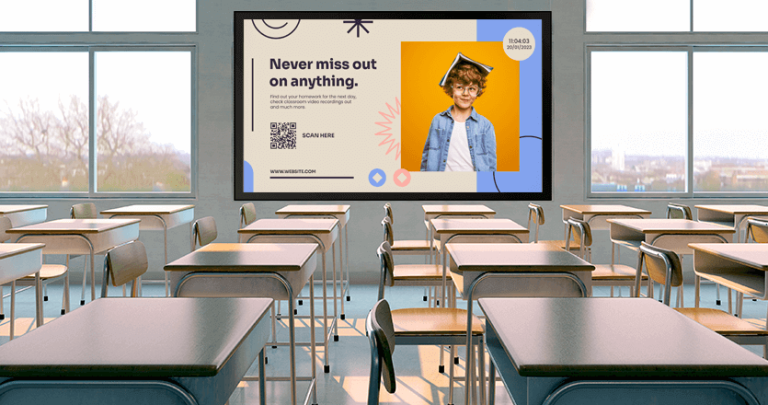As the educational landscape evolves, schools and institutions are continually seeking innovative methods to enhance communication and engagement within campus settings. One particularly transformative trend in the domain of educational technology has been the adoption of digital school signs. These dynamic displays are reshaping the way schools communicate with students, staff, and visitors, offering a plethora of benefits and applications that extend well beyond traditional signage.
Table of Contents
Modernizing Campus Messaging
With the advent of digital school signage, institutions are now equipped to broadcast timely and relevant information with unparalleled efficiency. The flexibility of digital screens allows for instant updates and the dissemination of messages across various points on a campus. This modernized approach to communication aids in ensuring that every individual on school grounds is informed and up-to-date on campus events, policies, and alerts.
Boosting Engagement and Interactivity
Interactive features are among the chief advantages offered by digital signs in educational settings. These systems can engage audiences with touch-screen capabilities, multimedia content, and even augmented reality experiences. As a result, students find themselves more engaged with school announcements and educational content, fostering a more interactive and participatory campus culture.
The Role of Digital Signs in Information Dissemination
The distribution of information on campus is more immediate with digital signs. Unlike static signs, digital displays can be updated in real-time, which is particularly advantageous during emergencies or when sharing last-minute changes. From wayfinding to event promotions and academic schedules, digital signage provides a centralised platform for all school communications.
Environmental sustainability is a significant concern in contemporary education. Digital signs offer an eco-friendlier alternative to paper-based communication, reducing waste and the reliance on physical resources. Transitioning to digital reduces the need for printed materials such as flyers, posters, and bulletins, thus contributing to eco-friendly campus initiatives.
Digital signs also carry the advantage of being highly customisable. They can reflect the school’s brand, showcase student achievements, and highlight cultural events with vibrant graphics and videos. This customisation not only contributes to a more visually appealing campus environment but also fosters a sense of belonging and pride among the school community.
Educational Integration
Across coursework and extracurricular activities, digital school signs play a pivotal role. They offer a platform to showcase student projects and classwork, potentially increasing motivation among students who see tangible recognition of their efforts displayed in public spaces. This visibility underscores the importance of academic and creative endeavours throughout the student body.
Cost-effectiveness may not be the first consideration when discussing technological advancements, but digital signage systems can be economically beneficial in the long term. While the initial setup may require a significant investment, the recurring costs related to updating and maintaining digital signs are considerably low compared to traditional signage solutions.
Enhancing School Safety
Safety is an uncompromisable aspect of any educational institution, and digital school signs enhance campus safety protocols. In the event of an emergency, these signs can quickly broadcast vital instructions and navigational guidance to ensure swift and orderly evacuations or other safety measures, helping to keep the campus community safe.
Technology integration in education extends to administrative processes as well. Digital signs can streamline administrative communication, reduce paper-based tasks, and present important deadlines, freeing up valuable resources and time that can be redirected towards education and student support services.
Moreover, digital school signs have become a central tool in promoting a health-conscious environment, especially pertinent in the ongoing climate of global health concerns. Signage can display public health guidelines, updates on campus health services, and reminders to adhere to healthy practices, reinforcing a culture of wellbeing.
Building Collaborative Partnerships
Partnerships between educational institutions and local businesses or organisations can be showcased through digital signage. Such collaborations can be publicised to encourage community engagement, while also providing platforms for sponsors or partners to reach out to the educational community in meaningful ways.
As we look to the future, the potential for integrating digital signage with other emerging technologies such as artificial intelligence and machine learning exists. This integration could tailor content to specific audiences and generate dynamic learning environments that adapt to the needs and behaviours of students and faculty alike.
Conclusion
In summary, the implementation of digital school signs brings forth a revolution in campus communication, enriching the educational environment and facilitating a more connected, informed, and responsive school community. Embracing such technologies not only prepares students for a digitised world but also establishes a foundation for ongoing innovation in educational communication and engagement.
Institutions worldwide continue to explore and adopt digital signage solutions, leveraging its vast potential to enhance education and streamline campus operations. The upward trajectory of this trend promises a future where digital school signage is an integral element of the educational infrastructure, propelling schools towards greater efficiency, sustainability, and community involvement.
The transformative power of digital signage in the educational sector aligns with the broader shift towards a more interconnected and technologically savvy society. Schools that harness the capabilities of digital signs position themselves at the forefront of educational innovation, ready to meet the challenges of the future and foster success amongst their students and staff.
